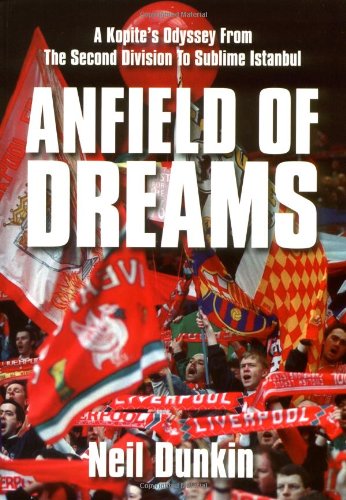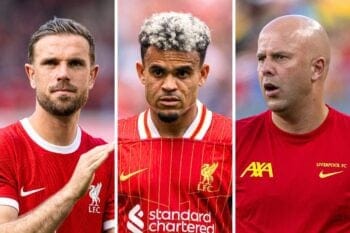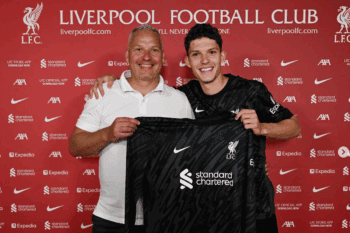
Journalist Neil Dunkin was brought up in the Lake District. No, not that one up the M6 but the cluster of streets with names like Coniston, Windermere and Thirlmere situated a couple of corner kicks from the Kop. All his life Neil has followed the Reds and now he has written an account of his 50 years of devotion. We caught up with recently to find out more about the book and the author.
“Anfield Of Dreams: A Kopite’s Odyssey From The Second Division To Sublime Istanbul’

TIA: Lots of fans have written books about supporting Liverpool, so what’s different about Anfield Of Dreams?
Neil: The time span and range of subjects. It’s not just ‘œand then Rushie scored the winner’. Obviously, that’s an important element but there’s a lot more to the book. Just take the period it covers.
I was born in the shadow of the Kop ‘“ all right, 400 metres away, in Ullswater Street, off Breck Road ‘“ and when I first went in the Boys’ Pen, the Reds were in the Second Division.
In fact, the book starts in Mid-Atlantic in April 1954 when Evertonians in the crew of the Queen Elizabeth liner organised a funeral service for Liverpool who’d just been relegated. They even had a coffin paraded around the decks and dropped in the sea. Yet, after Shanks masterminded promotion, we went on to win more honours than any other British club, climaxed by that unbelievable night in Istanbul in 2005. Being there was just the best thing ever. And before the game I managed a secret climb to the top of the tallest minaret in the Suleiman mosque. How many fans did that?
So I’ve supported the lads for half a century, from the depths to the heights. No other club in the world has been through what Liverpool have been through in the past 50 years. It’s a unique story, an amazing rollercoaster ride, from triumph to tragedy, then back to triumph.
.
It’s clear from your wild tales that travel’s one of your passions…
Yes, especially if I can combine it with football. The book covers trips abroad for games in cities like Rome, Paris, Brussels, Munich and Barcelona, as well as various adventures in exotic parts of the world such as Mexico, Brazil and the Andes.
So I write about a match in Mexico’s awesome Azteca arena where giant laser eagles flew round and round the oval roof before kick-off. I had drunk some mezcal but I wasn’t hallucinating.
I also went on a hair-raising taxi ride to Rio’s Maracana stadium. Our drunken driver was blasting through lights on red. Mad! But we got to the ground in one piece and watched the derby between Flamengo and Vasco da Gama. Some game. There was a crowd of 110,000 and the samba drummers were deafening. The Maracana is definitely my favourite stadium after Anfield.
Then I travelled around Peru, walking the Inca trail to Machu Picchu, and tried to climb a 19,000-foot volcano in Ecuador with my son, as you do. He was taken very ill with acute mountain sickness and I had to throw in the towel below the summit because of total exhaustion. That explains the chapter heading, Cotopaxi 2, Kopites 0, Match Abandoned.
.
The book has some graphic sections describing Liverpool’s role in military history…
I decided to research the Battle of Spion Kop in the Boer War because it gave its name to our Kop. Most fans have no idea how Scousers suffered in that battle. It was dreadful. They were sitting ducks for the Boers’ artillery, blown to bits because their commanders were callous and incompetent. Every Kopite should know the story of the sacrifices our lads made.
I’ve also described the horrors of the Blitz, because Merseyside played a massive part in defeating the Nazis, and I’ve dipped into family archives to tell how my Grandad sank a U-boat in the First World War. He was at the wheel of a troopship, the Titanic’s sister ship, the Olympic, which rammed the U-boat off Cornwall and I reproduce a letter thanking him for that. It was the only time a British merchant vessel sank a German submarine. I must say I’m proud of him.
.
As you say, Anfield Of Dreams covers a lot more subjects than football…
Football’s the thread binding it all together but it’s also the story of my life and long-time love affair with all things Liverpool, the football, the city, the people, the history and of course the music. I was going to the Cavern when the Beatles were on almost every day. I used to go at night and at lunchtime too, sitting eating my sarnies while the world’s greatest band played on stage. How lucky can you get!
I’ve also set out to give an insight into the marvellous community where I was brought up and how the people lived, the parties, the pubs, jobless men singing in the street, cap in hand, the escapologist doing his Houdini act on the bomb site at the bottom of the road, the moonlit flit when the rent hadn’t been paid. The schools I went to, Anfield Road primary and Alsop High, figure prominently because they helped make me who I am.
.
 So what happened to you after school?
So what happened to you after school?
After a spell in the Civil Service, I went to university in London, got a degree in French and returned to Merseyside as a trainee journalist on the Liverpool Daily Post and Echo. From there, I switched to national newspapers in Manchester, working as a sub-editor, the journalist who edits and designs pages. Then when the nationals started closing their Northern offices, I moved to London with my family and continued on papers there.
.
How long did it take to write the book?
It’s an in-depth account of my life and times, 380 pages in all, along with colour pictures, so I didn’t exactly rattle it off in a couple of months. I spent three years researching, reading and making notes and another three to write it.
.
How did you find a publisher?
With some difficulty. A rather frustrating experience, I can tell you. Writing a book is the easy part, getting it published is the real challenge.
Henry Winter, the Daily Telegraph football reporter, put me in touch with a literary agent who’s represented lots of players and managers. He liked what I’d written and agreed to take it on, although he did warn me major publishers were concentrating on ‘œcelebrity’ authors and fans’ memoirs could be difficult to place.
That’s how it turned out. After three months, the agent had approached 10 publishers without any success, so he advised me to try by myself. I sent off a synopsis and sample chapters to about 20 companies and that’s where the process got frustrating. Usually I rang beforehand to give some information about the book and to ask if they might be interested. If they were, I sent the chapters but some did not even have the courtesy to respond with a ‘œNo, thank you’. And I sent stamped addressed envelopes too! That’s not unprofessional, it’s ignorant. Anyway, just as I was weighing up self-publishing, Know The Score Books said it was right up their street and they brought it out.
.
Your book is a “Kopite’s Odyssey”, so what does the Kop mean to you?
Everything. There’s nowhere on the planet like it. I first went in there in the Fifties, in the wild and wonderful Boys’ Pen. You put any spare coppers down your sock, because big lads would frisk you, and around Bonfire Night you kept your hands in your pockets to stop bangers being stuffed in. You got a real education in there.
Once I reached mid-teens, I moved into the main part of the Kop, which in the Sixties and Seventies was just incredible with its songs and humorous chants. There were so many memorable games, like the match with Cologne in 1965. A blizzard covered the pitch with icy snow so the lines couldn’t be seen and the referee had to call the game off.
Everyone had to wait for vouchers for the rearranged tie to be handed out at the gates. While they were waiting, a ball was tossed on the pitch and a kickaround began ‘“ no sides, no rules, just a horde of blokes booting the ball anywhere, chasing it up and down the field.
Absolutely hilarious. No one could stay on their feet because it was so slippy. When the ball stuck in the snow, lads overran it and skidded to a halt in a heap of bodies. As they got to their feet, others came sliding in and knocked them over again, like skittles in a bowling alley. Meanwhile, the ball had been hacked up the other end, chased by the rest of the mob.
One bloke was so bladdered he couldn’t stand up after he was decked ‘“ he kept slipping over. In the end, he gave up and had to crawl across the snow into the paddock. Then the rabble massed in the centre circle and charged the Kop with the ball and belted it again and again into the goal. Imagine Kopites scoring at the Kop end. You’d never forget it.
That was one of the funniest nights ever at Anfield.
.
There are lots of stories about the Kop…
Well, it’s in a league of its own, so I decided to pay tribute to its originality and sense of comedy. I’ve listed loads of chants and songs and incidents. Most of them I knew already but people in the supporters’ club gave some new ones.
.
You’ve also got pages of Shankly anecdotes and quotations…
Yes. How could anyone write a book about Anfield over the last 50 years without going big on the great man? He was amazing. So I’ve collected as many tales as I could about him. I also talk about the one time I met him. That voice. It made my legs go like jelly
.
How’s the book been doing?
I’ve been encouraged by the feedback. It had smashing reviews in the Sunday Express and Birmingham Post and an American football podcast even rang from California to do an interview.
But what’s really chuffed me are the readers’ comments. People with no interest in football seem to have discovered the book and enjoyed it, like one woman who’s into golf and described it as ‘œriveting’. A West Ham fan also contacted me to say the Hillsborough chapter had him in tears. When someone who doesn’t support Liverpool is moved like that, it has to count for a lot.
.
Are you planning to write anything else?
I’m working on a football book that’s completely different from Anfield Of Dreams. In fact Liverpool isn’t the main subject, it’s the game in general. I’ve also been approached by a photographer, Adam Rubin, a season-ticket holder who wants me to do the words for a collection of pictures of fans.
.
Finally, what’s your view of developments at the club?
I remember walking out of the Bobby Moore stand at Upton Park one night in January 2007, just after we’d beaten the Hammers 2-1. There were TVs under the stand and they were giving news that Liverpool’s board were stalling over the takeover by Dubai International Capital.
I was stunned. DIC’s chief, Sami Al Ansari, is a Liverpool fan. He was in Istanbul. He represented our best chance of investment, yet the directors were having second thoughts. Soon afterwards the takeover was off and Hicks and Gillett moved in.
What’s hard to understand is why the Anfield hierarchy plumped for the Americans when their business methods and limited finances were public knowledge. People say certain individuals at the club did very nicely, thank you, out of the takeover but I’m sure that didn’t influence their judgement. Eventually the inside story will come out and it’ll be interesting to hear it. After all, fans should be owed an explanation.
Meantime I’m backing Share Liverpool FC and the Spirit of Shankly union and I’d urge everyone to join one or both. By sticking together, we can make a difference. The more pressure on our esteemed owners, the better for us. And there will be a light at the end of the tunnel. These may be difficult times but a half-century supporting the Mighty Reds has taught me one lesson: dreams can come true. In our darkest moments, we should all remember that.
 You can
You can 













